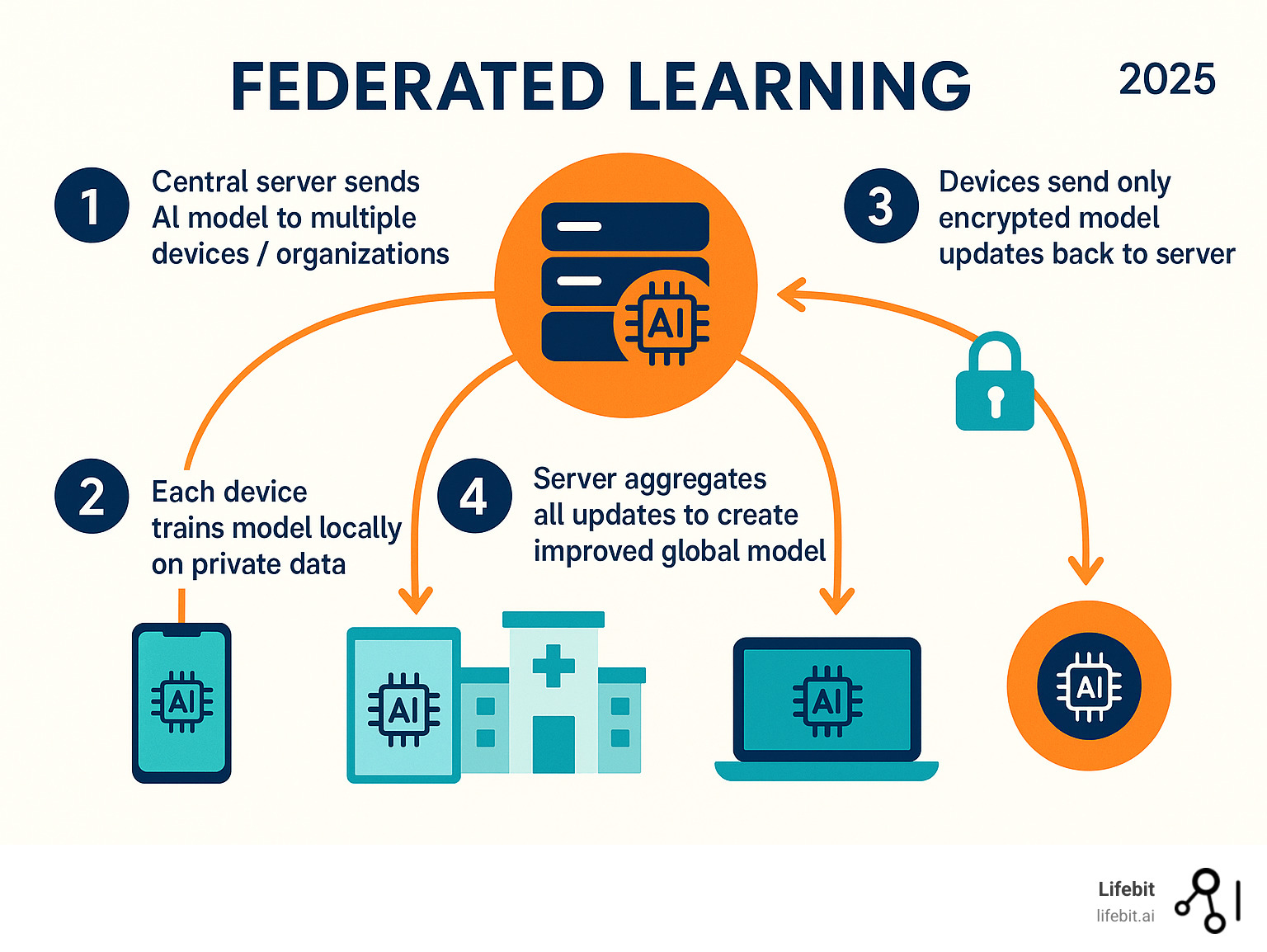From Smartphones to Smart Cities: The Power of Federated Learning Applications

Federated Learning Applications: 8 Groundbreaking Uses
Why Federated Learning Applications Are Changing Global Industries
Federated learning applications are revolutionizing how organizations collaborate on AI while keeping sensitive data secure. Instead of moving data to central servers, federated learning brings the AI model to the data. This enables powerful machine learning across industries like healthcare, finance, and automotive without compromising privacy.
Key applications include:
- Healthcare: Training diagnostic models across hospitals without sharing patient data.
- Mobile devices: Improving keyboards and voice assistants via on-device learning.
- Finance: Detecting fraud and assessing credit risk collaboratively.
- Automotive: Letting autonomous vehicles learn from collective driving experiences.
- Manufacturing: Enabling predictive maintenance without exposing trade secrets.
The technology solves a critical challenge: building better AI models together while keeping sensitive data private. Traditional machine learning requires centralizing data, which creates privacy risks. Federated learning avoids this by training models collaboratively while data stays where it belongs.
As CEO and Co-founder of Lifebit, my work focuses on developing federated learning applications that open up the power of global biomedical data while maintaining the highest standards of privacy and regulatory compliance.

Why Federated Learning is a Game-Changer for AI
Traditional machine learning hits a wall when data is locked in different organizations. Hospitals won’t share patient records, and banks can’t expose customer transactions. It needs all data in one place.
Federated learning applications flip this approach. Instead of demanding data, the AI model travels to the data. It’s a fundamental shift that solves one of AI’s biggest challenges: building powerful models when the most valuable data can’t be shared. This allows hospitals to collaborate on cancer research without patient records leaving their walls, and banks to catch fraudsters while keeping customer data private.
The core principles making this possible are:
- Data sovereignty: Your data stays under your control, which is often legally required by regulations like GDPR.
- Collaborative intelligence: Organizations can work together on AI without privacy roadblocks, resulting in more robust and accurate models.
- Reduced latency: On-device learning, like on a smartphone keyboard, provides instant responses without relying on cloud servers.
- Scalability: The system grows with your network, from ten hospitals to ten thousand smartphones, without a central data bottleneck.
| Feature | Traditional Machine Learning | Federated Learning |
|---|---|---|
| Data Location | Centralized | Decentralized (data stays local) |
| Privacy Risk | High (data aggregation) | Privacy-preserving |
| Architecture | Single Point of Failure | Robust & Scalable |
How the Federated Learning Process Works
The process is a neat dance of collaboration:
- Initialization: A central server creates a starting AI model and sends it to all participants (e.g., hospitals, smartphones).
- Local training: Each participant trains the model on their own private data. No data leaves its source.
- Model updates: Instead of raw data, each participant sends back only the mathematical updates representing what the model learned. These updates are small and can be encrypted.
- Secure aggregation: The central server collects and combines all updates into an improved global model, often using techniques that prevent it from seeing individual contributions.
Federated averaging is the mathematical core of this process, efficiently combining local improvements. This cycle repeats, making the model smarter with each round. For a deeper dive, a comprehensive overview of FL strategies explores recent developments.
Key Types of Federated Learning
Federated learning comes in several flavors:
- Centralized FL: A central server coordinates the entire process. It’s straightforward and common for business applications.
- Decentralized FL: Participants communicate directly with each other (peer-to-peer), creating a more resilient network.
- Cross-silo FL: A small number of large organizations (e.g., hospitals, banks) collaborate, each holding a large dataset.
- Cross-device FL: A massive number of smaller participants (e.g., smartphones, IoT sensors) contribute, each providing a small piece of the puzzle.
- Heterogeneous FL: This advanced type handles the reality of participants having different computing power, connection speeds, and data types.
8 Groundbreaking Federated Learning Applications Changing Industries

Federated learning applications are actively reshaping industries by enabling powerful AI while respecting data privacy. They leverage distributed data to build more robust and intelligent models, demonstrating the power of collective intelligence. Let’s dig into some of the most impactful real-world examples.
1. Healthcare: Pioneering Federated Learning Applications for Patient Privacy
The healthcare sector is where federated learning applications have a profound impact. Patient data is incredibly sensitive, and regulations like HIPAA make centralized approaches difficult. Federated learning allows hospitals to collaborate on powerful AI models without sharing raw patient data.
- Drug Findy: Pharmaceutical companies can use federated learning to accelerate the findy of new treatments. The MELLODDY project, for example, brought together ten pharma companies to train models on chemical data without sharing proprietary compounds, speeding up the identification of potential drug candidates.
- Medical Imaging Analysis: Training AI to interpret X-rays, MRIs, and CT scans requires diverse datasets. Federated learning lets multiple medical centers train models together. For instance, a collaboration of 20 institutions developed a model to predict oxygen needs in COVID-19 patients with high accuracy, leading to better patient outcomes.
- Predictive Health: Hospitals can collaboratively train models to predict patient outcomes, readmission risks, or disease likelihood. This enables personalized treatment plans and proactive care by learning from a global patient population while data remains local and secure.
- Rare Disease Detection: Diagnosing rare diseases requires identifying subtle patterns across many sources. Federated learning allows researchers to train models on patient data from around the globe, significantly improving diagnostic accuracy for uncommon conditions without centralizing sensitive information.
At Lifebit, we are pioneering federated trusted research environments for secure, large-scale research. Our platform enables advanced models for predicting health outcomes, facilitating pharmacovigilance, and supporting global precision medicine initiatives. We empower researchers to open up the full potential of biomedical data through technologies like our Lifebit Federated Biomedical Data Platform and privacy preserving statistical data analysis on federated databases.
2. Mobile Devices: Everyday Federated Learning Applications
Our smartphones use federated learning applications to create personalized experiences while keeping our data private.
- Predictive Keyboards: On-device keyboards improve next-word prediction by learning from your typing patterns locally. Only model updates are sent and aggregated, resulting in accurate suggestions without compromising privacy.
- Smart Text Selection: Modern devices intelligently highlight addresses or phone numbers. This is improved by federated learning based on how users interact with selections on their devices.
- Voice Assistants: On-device assistants improve speech recognition by learning from your commands locally, without voice recordings leaving your phone.
- Personalized Recommendations: Apps can offer relevant news or content by learning from your on-device usage patterns, without sharing your browsing history centrally.
3. Finance: Securing Transactions and Assessing Risk
The finance industry uses federated learning applications to collaborate on security and services without pooling confidential customer data.
- Fraud Detection: Banks can collaboratively train more robust fraud detection models. Each bank trains a model on its own transaction data, and the aggregated insights create a global model that can detect complex fraud schemes invisible to a single institution.
- Credit Scoring: Lenders can contribute to a shared model that predicts creditworthiness more accurately, leading to fairer lending decisions without revealing individual customer financial details.
- Anti-Money Laundering (AML): Federated learning enables collaborative AML efforts, enhancing detection of illicit financial flows while maintaining client confidentiality.
4. Automotive: Accelerating the Path to Autonomous Vehicles

Developing autonomous vehicles (AVs) requires immense data. Federated learning applications allow vehicles to learn collectively without sharing raw driving footage.
- Real-time Traffic Prediction: Vehicles contribute to a global model that predicts traffic patterns in real-time, creating an accurate and up-to-date system.
- Road Hazard Detection: When a vehicle encounters a pothole, it can train a local model. These updates are shared via federated learning to alert other vehicles to potential dangers.
- Continual Model Improvement: Federated learning enables a continuous feedback loop where AV models are constantly updated based on new driving scenarios observed by the fleet. Industry initiatives are exploring this for cross-border training.
5. Smart Manufacturing (Industry 4.0)
In Industry 4.0, federated learning applications provide a secure way to collaborate on process optimization without sharing proprietary data.
- Predictive Maintenance: Multiple factories can collaboratively train a model to predict equipment failures. Each factory’s data stays local, but the shared model learns from the collective experience, reducing downtime.
- Quality Control: Different production lines can contribute to a shared quality control model, enabling it to learn from a wider variety of defects and improve overall product quality.
- Industrial IoT (IIoT): Federated learning is a natural fit for IIoT, allowing countless sensors to learn and adapt collaboratively, optimizing energy use and efficiency without transmitting all raw sensor data.
6. Retail & E-commerce
Retailers use federated learning applications to gain collective intelligence without compromising customer privacy.
- Personalized Product Recommendations: Recommendation models can be trained on user behavior directly on customer devices. This allows for highly personalized suggestions without revealing individual shopping habits.
- Customer Churn Prediction: Businesses can collaboratively build more accurate churn prediction models by learning from a broader range of customer interactions without sharing sensitive profiles.
- Inventory Management: By collectively learning from sales data across multiple stores via federated learning, retailers can improve their demand forecasting, leading to optimized stock levels and reduced waste.
7. Robotics
Federated learning applications enable robots to learn collaboratively and continuously improve their capabilities.
- Swarm Robotics: A fleet of drones or ground vehicles can learn from their local environments and share model updates to improve collective behavior for tasks like exploration or search and rescue, as shown in research on Federated Reinforcement Learning for Collective Navigation of Robotic Swarms.
- Collaborative Navigation: Robots can learn to steer complex environments more effectively by sharing learned models, adapting quickly to obstacles found by other robots in the fleet.
- Lifelong Learning: Federated learning supports continuous adaptation in dynamic environments. As individual robots gather new data, they contribute to an evolving global model, a concept explored in studies like Lifelong Federated Reinforcement Learning.
8. Smart Cities & IoT
Smart cities rely on vast IoT networks. Federated learning applications offer a decentralized, privacy-preserving approach to processing this data.
- Energy Consumption Optimization: Smart buildings can train models to optimize HVAC systems for energy efficiency based on unique usage patterns. Aggregated insights improve global energy management without sharing specific building data, as noted in studies like Employing Federated Learning for Training Autonomous HVAC Systems.
- Environmental Monitoring: Sensors across a city can collaboratively train models to predict air pollution patterns, helping city planners make informed decisions while sensor data remains localized.
- Traffic Flow Management: Federated learning allows different traffic systems to collaboratively optimize signal timings and route suggestions by learning from real-time data across the city without centralizing sensitive movement patterns. Our work in federated data analysis extends to these complex datasets.
Navigating the Challenges and Future of Federated Learning
While federated learning applications are transformative, they come with unique challenges:
- Data Heterogeneity: Real-world data is not uniform. Datasets from different sources can vary in size, quality, and statistical properties, which can complicate training a single global model.
- Communication Costs: While FL avoids transferring large datasets, it requires frequent communication of model updates. This can be a bottleneck on networks with limited bandwidth.
- Device Reliability: Consumer devices or IoT sensors may drop offline due to low battery or poor connectivity, which robust FL systems must be engineered to handle.
- Security Risks: Malicious actors could attempt model poisoning (sending corrupt updates to sabotage the model) or inference attacks (trying to reverse-engineer private data from model updates).
Advanced Privacy and Security Solutions
To address these risks, researchers have developed powerful privacy-preserving techniques:
- Differential Privacy: Adds mathematical “noise” to model updates, making it statistically impossible to extract information about any single individual’s data.
- Secure Aggregation (SCA): Uses cryptography to allow the server to combine encrypted updates without ever seeing the individual contributions.
- Homomorphic Encryption: Allows computations to be performed directly on encrypted data, offering an extremely high level of privacy.
- Trusted Execution Environments (TEEs): Hardware-based secure zones that isolate computations, preventing even system administrators from inspecting them.
At Lifebit, our commitment to privacy preserving statistical data analysis on federated databases leverages these techniques to deliver secure solutions for life sciences.
The Future Outlook for Federated Learning
The future of federated learning applications is bright, with several exciting trends:
- Federated Reinforcement Learning: Enables intelligent agents like robots or autonomous vehicles to learn optimal behaviors collaboratively.
- Personalized FL: Creates customized local models that benefit from collective knowledge while being custom to individual needs.
- Integration with Blockchain: Can provide a transparent, tamper-proof ledger for model updates in decentralized networks.
- 6G Networks: Ultra-low latency and massive connectivity will reduce communication bottlenecks, enabling larger-scale, real-time deployments.
The emergence of new tools and frameworks continues to make federated learning more accessible, paving the way for global collaborative intelligence that respects data privacy and security.
Frequently Asked Questions about Federated Learning
We understand that federated learning applications can seem complex. Here are answers to some common questions.
What is the main advantage of federated learning?
The main advantage is privacy. Traditional machine learning requires centralizing sensitive data, which is often impossible due to regulations like GDPR and HIPAA. With federated learning, data never leaves its source location. This enables collaboration on sensitive datasets that would otherwise remain locked in silos. It allows organizations to build more robust and accurate AI models by tapping into diverse, global data pools without compromising privacy.
Can federated learning guarantee 100% privacy?
No technology can guarantee 100% privacy. However, federated learning significantly improves privacy over centralized methods by keeping raw data local. The primary risk involves sophisticated inference attacks, where an attacker tries to reverse-engineer data from model updates. To counter this, we use additional layers of protection. Techniques like differential privacy and secure aggregation provide strong mathematical guarantees that make it extremely difficult to compromise individual privacy. At Lifebit, our platform incorporates multiple privacy-preserving techniques to ensure the strongest possible protections.
Is federated learning slower than traditional centralized learning?
It can be, primarily due to communication bottlenecks. The process requires multiple rounds of updates between participants and the central server, which can be slowed by network latency or unreliable devices. However, federated learning avoids the massive data transfer times required to move terabytes of data to a central location—a process that is often impractical or prohibited. As communication-efficient algorithms improve, this speed trade-off is becoming less of an issue, especially when the alternative (centralized learning) is not feasible.
Conclusion: The Dawn of a New Era in Collaborative AI
Federated learning applications represent a fundamental shift in AI collaboration, breaking down the privacy barriers that have long siloed sensitive data. From healthcare and finance to autonomous vehicles and smart cities, this technology enables organizations to build more robust, intelligent systems by learning from diverse, real-world data.
Federated learning’s transformative impact aligns technological capability with ethical responsibility. We no longer have to choose between powerful AI and protecting privacy—we can have both.
For organizations in life sciences, Lifebit’s platform provides a next-generation federated AI solution for compliant, large-scale research. Our Trusted Research Environment (TRE) and other tools empower biopharma, governments, and public health agencies to accelerate drug findy and improve patient outcomes. This is achieved while ensuring data remains private at its source, enabling secure collaboration across hybrid data ecosystems.
The future of AI is collaborative, responsible, and privacy-preserving. Federated learning applications are lighting the way forward.


